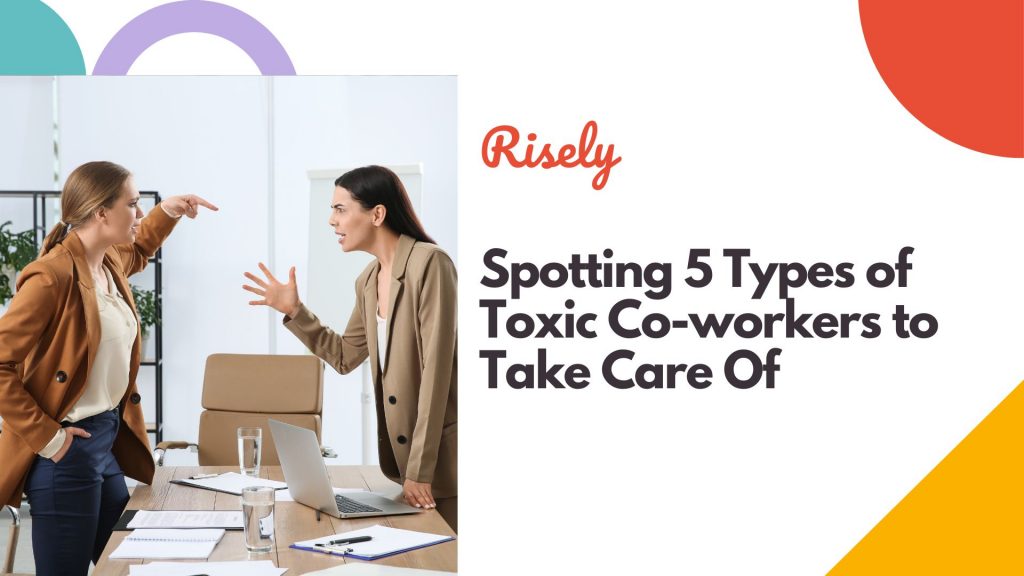Have you ever felt like a dark cloud follows a certain co-worker around? Their negativity is contagious, their presence drains your energy, and working with them feels like navigating a minefield. These, my friend, are the toxic co-workers – the emotional vampires of the office.
From rumor-mongering gossips to micromanaging nitpickers, these individuals can wreak havoc on your productivity, morale, and even your mental health. But fear not! By understanding the different types of toxic co-workers and learning effective strategies to deal with them, you can transform your work environment from a tense battleground to a tranquil oasis of productivity.
So, grab your metaphorical hazmat suit, because we’re about to delve into the world of toxic co-workers. We’ll identify the different breeds, equip you with tips to neutralize their negativity, and empower you to protect your peace of mind. Let’s get started!
What is a Toxic Co-Worker?
Toxic co-workers are people who frequently exhibit negative behavior that has a detrimental impact on the workplace. They can create an unhealthy environment by spreading negativity, gossiping, or being overly critical of others. This can lead to decreased productivity, low morale, and high employee turnover. They also engage in bullying behavior, belittle others, or harass colleagues verbally, emotionally, or even physically. Toxic co-workers can hinder productivity in multiple ways. These types of toxic co-workers may create distractions, foster conflicts and tension that divert attention from work, or actively sabotage the efforts of others. This can lead to decreased focus, efficiency, and overall output. Therefore, identifying and addressing toxic behavior early on, as establishing boundaries to maintain a positive work environment, is vital.Explaining the Signs of a Toxic Co-Worker through Real-Life Scenarios
The signs of a toxic co-worker includes:- A negative attitude towards other co-workers.
- A lack of accountability in the workplace.
- Exhibiting poor communication skills which are misconstrued by other co-workers.
- Exhibiting a manipulative behavior.
What does toxic behavior look like in real life?
Scenario 1: Lisa constantly spreads rumors and gossip in the workplace. She frequently initiates conversations centered around spreading rumors or sharing personal information about others. She takes pleasure in stirring up drama and manipulating situations to her advantage and often targets specific individuals, tarnishing their reputation and creating a toxic and untrusting work environment. Scenario 2: Mark engages in passive-aggressive behavior towards his colleagues showcases toxicity in the workplace. He frequently makes sarcastic remarks disguised as jokes, making others uncomfortable and often uses non-verbal cues like eye-rolling, sighing, or dismissive body language to express his disapproval or disdain. Both Lisa and Mark are types of toxic co-workers who exhibit toxic behaviour in the workplace which has a negative impact on their co-workers as well as on the work environment.The Types of Toxic Co-Workers
Workplaces can be destroyed by the types of toxic co-workers who display negative behavior consistently. Toxic co-workers often engage in behaviors that undermine their colleagues’ work, success, or confidence. This can include spreading false information, taking credit for others’ achievements, or intentionally withholding important information. They consistently exhibit a negative attitude, complaining, criticizing, and focusing on problems rather than solutions. Their pessimistic outlook can drain morale and create a toxic atmosphere. Toxic co-workers show little empathy or consideration for others’ feelings, needs, or perspectives. They may disregard boundaries, belittle others, or engage in insensitive behavior. These types of toxic co-workers exhibit the above-mentioned traits and they come in various forms. Let’s look at some of them listed below.The Gossipmonger
The Gossipmonger is a type of toxic co-worker who actively engages in spreading rumors, gossip, and potentially harmful information about others in the toxic workplace. They thrive on gathering and disseminating information, often without considering the accuracy or consequences of their actions. They enjoy stirring up drama and create a sense of mistrust and tension among colleagues. This type of toxic co-worker may also manipulate information to serve their own agenda or to gain attention and power.The Micromanager
A Micromanager emerges as a curious specimen—a being whose essence revolves around an insatiable hunger for control and an unyielding desire to orchestrate every detail of their subordinates’ work. They tend to control every aspect of the work. This unwarranted behavior leads to delays and eventually hampers productivity. They unknowingly or perhaps knowingly, become a catalyst for toxicity within the workplace. This type of toxic co-worker has an excessive need for control which cultivates an atmosphere of distrust, inhibiting open communication and stifling the growth of collaboration. The best way to tackle this is by establishing clear boundaries and asserting your expertise in front of them. It is always best to discuss expectations upfront and communicate regularly so that they are kept in the loop about the progress of the work.The Constant Complainer
There are various types of toxic co-workers who come in many shapes and sizes; one such type is the Constant Complainer. They have a pessimistic perspective on various aspects of work, always highlighting the negative aspects and disregarding the positive aspects. They constantly criticize projects, policies, or colleagues without offering constructive feedback. This toxic co-worker is consistently dissatisfied with their work, the organization, or the team. They find faults in almost everything and are rarely satisfied with the outcomes or achievements. Their dissatisfaction spreads negativity and demotivates others. The Constant Complainer’s negative attitude and chronic dissatisfaction significantly impacts team morale and dynamics.A Narcissist
A narcissistic co-worker is excessively focused on themselves and their own needs, often disregarding the perspectives and concerns of others. They dominate conversations, steer discussions towards their own achievements, and seek attention and validation. They believe that they are inherently deserving of special treatment and privileges. They expect preferential treatment, disregard rules and boundaries, and feel entitled to resources and recognition without putting in equal effort. They crave excessive admiration and validation from others. They seek constant praise and recognition for their accomplishments, and they may become resentful or dismissive when they don’t receive the level of attention they desire.Social Media Addiction and the Kiss-up Culture
Kiss-up culture, where some colleagues flatter their bosses at the expense of others, adds fuel to toxicity and creates a toxic work environment. This behavior causes resentment and distrust among team members, leading to dissatisfaction and doom in the workplace. Toxic work environments characterized by excessive social media/email use and kiss-up culture can have detrimental effects on productivity, teamwork, and overall job satisfaction. Excessive use of Facebook or email during work hours leads to decreased productivity and negativity among coworkers.What are the Harmful Effects of a Toxic Co-Worker?
Imagine this: you’re laser-focused on a project, deadline looming large. Suddenly, a coworker pops by, venting frustration about a different project and peppering you with negativity. By the time they leave, your own motivation has taken a nosedive. That’s the power of a toxic co-worker – their negativity can be as contagious as a cold. But the damage goes far beyond a temporary mood swing. Chronic exposure to a toxic co-worker can wreak havoc on your well-being in several ways:- Stress and Anxiety: Working around negativity is like being on constant high alert. You never know what kind of mood your coworker will be in, or how they might react to something you say or do. This constant uncertainty can trigger the fight-or-flight response, leaving you feeling stressed and anxious.
- Decreased Productivity: It’s hard to focus on your work when you’re constantly interrupted by negativity or walking on eggshells around a difficult co-worker. Their drama can easily become a distraction, stealing your focus and hindering your ability to get things done.
- Low Morale: A negative attitude is like a virus – it can easily spread throughout a team. When one person is constantly bringing everyone down, it can erode morale and make it difficult for anyone to feel motivated or enthusiastic about their work.
- Burnout: The combined effects of stress, anxiety, and decreased productivity can lead to burnout. You may start to feel emotionally and physically drained, and lose all motivation to go to work.
- Physical Health Problems: Chronic stress can manifest in a variety of physical symptoms, such as headaches, stomachaches, and difficulty sleeping. In severe cases, it can even contribute to more serious health problems.
- Mental Health Issues: Exposure to a toxic co-worker can worsen symptoms of anxiety or depression, and in some cases, even contribute to the development of these conditions.
How to deal with Various Types of Toxic Co-Workers?
In the realm of professional relationships, where dynamics can sometimes turn toxic, it is crucial to recognize that no matter how challenging the situation may seem, there are always solutions available. While some connections bring joy and fulfillment, others can become entangled in toxicity, casting a shadow over our work environment and overall well-being. If you have ever experienced the distressing presence of the types of toxic co-workers mentioned above, rest assured that you are not alone, and there is indeed a way out of it. In the following sections, actionable strategies and insights are present to navigate these treacherous dynamics of toxic co-workers in your workplace. So, take a deep breath, fortify your resolve, and let us unravel the secrets to dealing with toxic co-workers and creating a harmonious work life.Be Assertive
Handling many types of toxic co-workers can be challenging, but being assertive is the best way to deal with it. It is essential to set boundaries and communicate clearly without engaging in gossip or drama. Clearly communicate your boundaries and expectations regarding their behavior. Explain how their actions are impacting you and propose alternatives or changes that you would like to see. Allow them to express their perspective and actively listen without interruption. If the toxic behavior persists despite your assertive communication, establish clear consequences, such as involving a manager or a team leader.Show Empathy
Showing empathy towards the different types of toxic co-workers can go a long way in creating a better work environment. Despite their negativity and toxicity towards you or others in the team, it’s essential to maintain a professional demeanor while setting clear boundaries with the toxic co-workers. Try to understand the underlying reasons behind their toxic behavior. Consider their personal struggles, insecurities, or work-related pressures that might contribute to their negative attitudes or actions. Recognizing their pain or challenges can help you approach them with compassion. Additionally, maintain a respectful tone and avoid retaliating with negative or aggressive actions. If appropriate, provide information or resources that could assist them in overcoming their challenges.Set Boundaries
Setting boundaries is a potent solution for dealing with different types of toxic co-workers. Boundaries serve as the invisible force field that shields your well-being and establishes a line of respect and self-preservation. Take time to understand your limits, values, and what is essential for your well-being in the workplace. Reflect on how the toxic co-worker’s behavior affects you personally and professionally. Determine what actions or interactions you are comfortable with and where you draw the line. Be clear and specific about your boundaries to avoid ambiguity. If any type of toxic co-worker violates your boundaries, calmly and assertively remind them of the limits you have established.How to Avoid being a Type of Toxic Co-Worker Yourself?
To steer clear of being any type of toxic co-worker, be conscious of your own behaviors, attitudes, and their impact on others. Reflect on your communication style, responses to feedback, and how you contribute to the overall work environment. Put yourself in others’ shoes and strive to understand their perspectives and feelings. Show empathy and compassion towards your colleagues, participate in active listening and support them when needed. Foster a collaborative and supportive work environment. Respect personal boundaries, cultural differences, and individual work styles. Embrace diversity and inclusivity, fostering a sense of belonging for all team members.Conclusion
Don’t let a bad apple spoil the whole bunch! Toxic co-workers can be a real drag, but by understanding the different types and developing strategies to deal with them, you can transform your work environment. Remember, you have the power to control your own reactions and set boundaries. If things escalate, don’t hesitate to seek support from HR or your manager. The goal is to create a work environment where everyone feels respected, valued, and empowered to do their best work. So, take a deep breath, equip yourself with the tips from this blog, and go forth and conquer those workplace toxins! Now go forth and build a positive, productive team!Test your assertive communication skills that will help you gain perspective in dealing with a toxic co-worker.
Take an assessment based on assertive communication and look at how well you do it.






